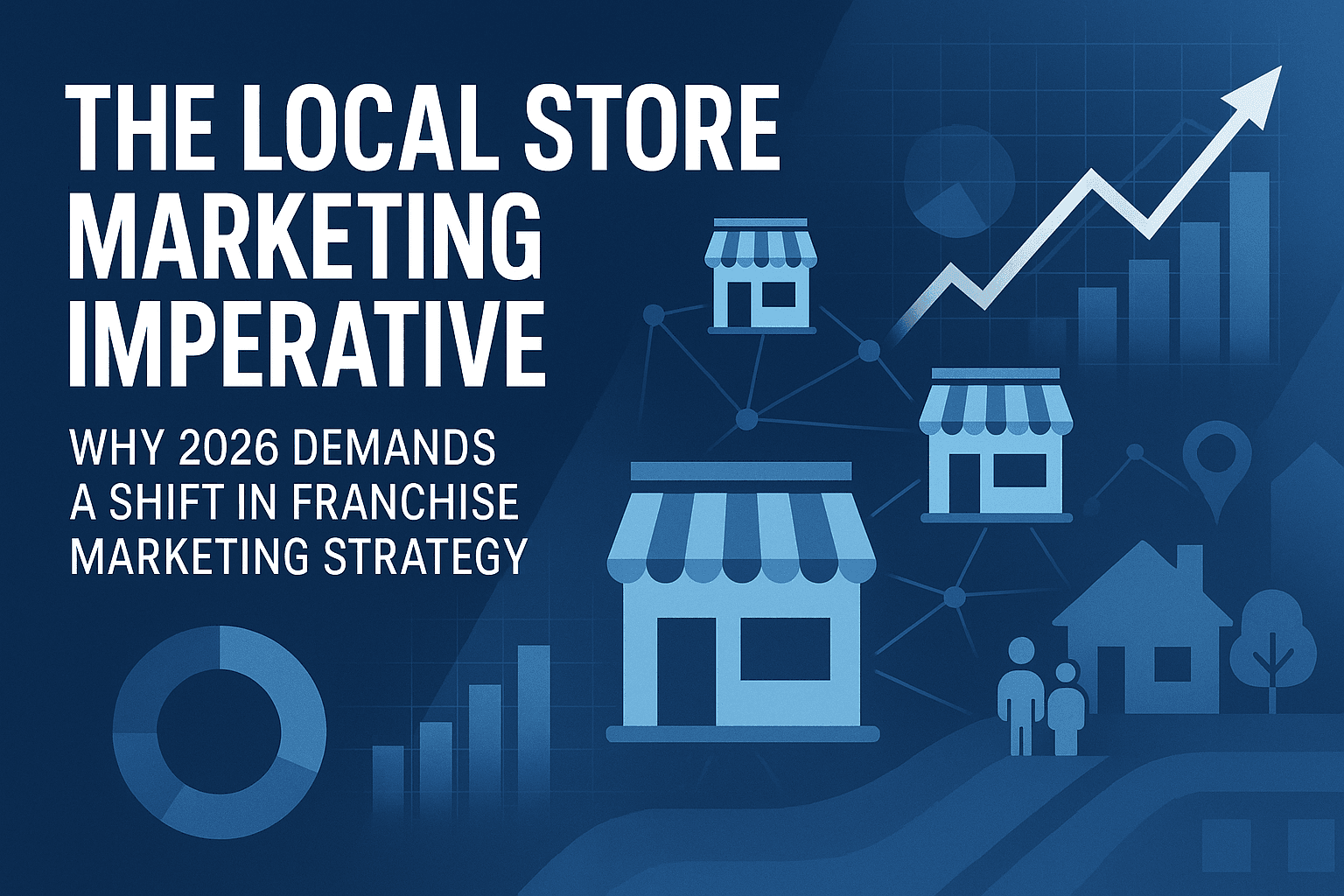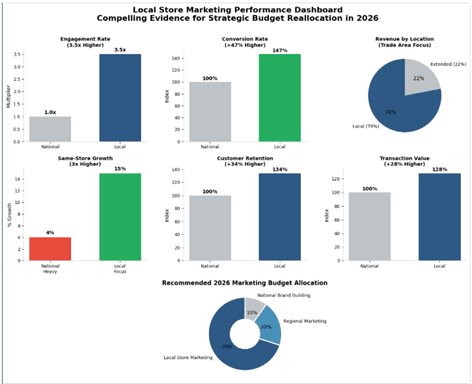Brett Campbell
CMO at LOMA

The Local Store Marketing Imperative: Why 2026 Demands a Shift in Franchise Marketing Strategy
Marketing leaders in multi-unit franchise systems are standing at a crossroads. The traditional approach of heavy national media spending and centralized campaigns is rapidly losing effectiveness, while local store marketing continues to prove its superior return on investment. As we approach 2026, the data is clear: franchises that fail to prioritize local store marketing in their budget allocations will find themselves at a severe competitive disadvantage.
This isn't a suggestion—it's an urgent call to action. The window for adaptation is narrowing, and franchise marketing decision-makers who don't act now risk watching their market share erode to more nimble competitors who understand the fundamental shift happening in consumer behavior and media consumption.
The Undeniable Case for Local Store Marketing in 2026
The statistics surrounding local marketing effectiveness are not merely compelling—they're overwhelming. Recent industry analysis reveals that local marketing efforts generate 3.5 times higher engagement rates compared to national campaigns for franchise businesses. More critically, local store marketing delivers a 47% higher conversion rate when measured against traditional national media spending.
Consider the implications: while your national advertising reaches millions with a generic message, your local store marketing creates meaningful connections with the customers who actually walk through your doors. The average consumer sees over 5,000 advertisements daily, but local community engagement cuts through this noise in ways that national media simply cannot replicate.
Multi-unit franchise systems that have embraced local store marketing are seeing remarkable results. Franchise brands allocating 60% or more of their marketing budget to local initiatives report average same-store sales growth of 12-18% annually, compared to just 3-5% growth for brands maintaining traditional national-heavy marketing approaches.
The Trade Area Connection: Where Real Revenue Lives
Every franchise location exists within a specific trade area—a geographic region containing the customers who will actually generate revenue for that unit. National advertising may build brand awareness, but it's the connection with trade area customers that drives foot traffic, builds loyalty, and creates sustainable revenue growth.
Research conducted across 2,847 franchise locations demonstrates that customers living within a 3-mile radius of a franchise unit account for 78% of that location's total revenue. Yet most franchise systems continue to spend 70-80% of their marketing budget on national campaigns that treat all geographic markets identically.
Local store marketing allows each franchise unit to address the specific needs, preferences, and cultural nuances of their immediate trade area. A franchise location in suburban Phoenix requires different messaging, different community partnerships, and different promotional strategies than a location in downtown Chicago or rural Tennessee. National campaigns, by their very nature, cannot accommodate these crucial local variations.
The National Media Delusion: Why Bigger Isn't Better
Marketing decision-makers have been conditioned to believe that national media buying provides superior reach and efficiency. This assumption is increasingly false for franchise businesses, particularly in an era where consumers actively seek authentic, local connections with brands.
National advertising suffers from three fundamental problems in the franchise context:
Geographic Waste: National campaigns spend significant budget reaching consumers who live nowhere near a franchise location, generating zero return on investment.
Message Dilution: Generic national messaging fails to address local market conditions, competitor landscapes, or community-specific needs.
Attribution Challenges: National campaigns make it nearly impossible to determine which marketing dollars actually drove customers to specific franchise locations.
Meanwhile, local store marketing delivers measurable, trackable results directly to the franchise units that need revenue growth. Local digital advertising, community partnerships, neighborhood events, and locally-targeted promotions create immediate, quantifiable returns that can be measured in foot traffic, sales increases, and customer acquisition.
The Technology Solution: Controlled Local Marketing at Scale
The most sophisticated franchise systems are already implementing local store marketing management platforms that solve the traditional challenge of maintaining brand consistency while empowering local marketing execution. These tools represent the future of franchise marketing, and early adopters are gaining significant competitive advantages.
Effective local store marketing management platforms provide several critical capabilities:
Brand Control Parameters Marketing leaders can establish brand guidelines, approved messaging frameworks, visual identity standards, and campaign templates that ensure local marketing efforts maintain brand integrity while allowing for local customization and execution flexibility.
Franchisee Empowerment Tools Local franchise operators gain access to user-friendly interfaces that enable them to create locally-targeted campaigns, manage community partnerships, customize promotional offers, and execute neighborhood-specific marketing initiatives without requiring extensive marketing expertise.
Performance Analytics and Attribution Advanced platforms provide granular tracking of local marketing performance, allowing both corporate marketing teams and individual franchisees to see exactly which local initiatives drive the highest returns and adjust strategies accordingly.
The 2026 Budget Imperative: Act Before It's Too Late
As marketing budgets for 2026 are being finalized, franchise marketing leaders face a critical decision. The data overwhelmingly supports a dramatic shift toward local store marketing allocation, but organizational inertia and traditional thinking continue to drive budget decisions toward ineffective national spending.
Industry analysis suggests that optimal franchise marketing budget allocation for 2026 should follow this framework:
65-70% allocated to local store marketing initiatives and trade area development
20-25% dedicated to regional marketing campaigns targeting specific geographic clusters
10-15% reserved for national brand building and franchise recruitment support
This represents a complete inversion of traditional franchise marketing budget allocation, but the performance data supports this dramatic shift. Franchise systems that continue to allocate 70-80% of marketing budget to national campaigns will find themselves increasingly unable to compete with local marketing-focused competitors.
Implementation Strategy: Making the Transition
Successful transition to local store marketing-focused budget allocation requires careful planning and the right technology infrastructure. Marketing leaders should immediately begin evaluating local store marketing management platforms that can support their franchise network's specific needs.
The most effective implementations follow a structured approach:
Phase 1: Technology Selection and Pilot Program Identify and implement a local store marketing management platform that provides appropriate brand control parameters while empowering franchisee marketing execution. Launch with a small group of high-performing franchise locations to demonstrate effectiveness and refine processes.
Phase 2: Franchisee Training and Support Develop comprehensive training programs that enable franchise operators to effectively utilize local marketing tools and strategies. Provide ongoing support to ensure consistent execution and optimal results.
Phase 3: Budget Reallocation and Scale Gradually shift budget allocation from national to local marketing initiatives based on pilot program results and franchisee capabilities. Scale successful local marketing strategies across the entire franchise network.
Conclusion: The Choice Is Clear
The evidence is overwhelming: local store marketing delivers superior results for multi-unit franchise systems compared to traditional national marketing approaches. The technology exists to implement local marketing at scale while maintaining brand control. The only question remaining is whether franchise marketing leaders will make the necessary changes before competitors gain an insurmountable advantage.
2026 budget decisions being made today will determine which franchise systems thrive in an increasingly competitive marketplace and which fall behind due to outdated marketing strategies. The data supports local store marketing. The technology enables it. The only missing element is the leadership decision to embrace this fundamental shift in marketing effectiveness.
The time for incremental changes has passed. Franchise marketing success in 2026 and beyond belongs to the systems that recognize local store marketing as the primary driver of franchise unit success and allocate their budgets accordingly. The choice is clear—the only question is whether marketing leaders will make it in time.

Comprehensive Performance Dashboard: Visual evidence supporting the strategic shift to local store marketing
This analysis is based on industry data compiled from franchise performance studies, consumer behavior research, and marketing effectiveness analyses conducted throughout 2024.
Featured resources
Resources we think you should read.
The Local Store Marketing Imperative: Why 2026 Demands a Shift in Franchise Marketing Strategy
The data is clear: franchises that fail to prioritize local store marketing in their budget allocations will find themselves at a severe competitive disadvantage. The traditional approach of heavy national media spending is rapidly losing effectiveness.
2025 Annual Franchise Marketing Report: Data Shows Gaps in Local Marketing Oversight
85% of brands in the survey recognize local marketing as essential for driving customer connections. Franchise systems that balance tech innovation with disciplined local marketing support are best positioned to build lasting customer relationships and maximize ROI.
Why is local store marketing so hard to scale for multi unit brands and what is LOMA doing about it?
Why is local store marketing so hard for multi unit brands to scale and what is LOMA doing about it? Let me give you my take on answering this question as I have 25+ years of experience in the field marketing space for multi-unit brands.

